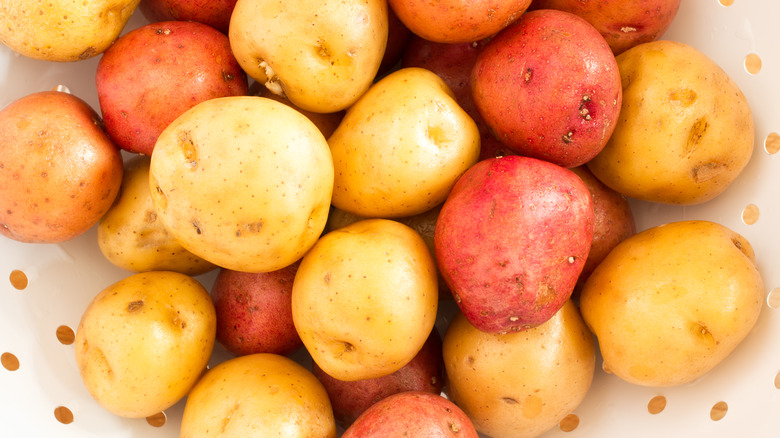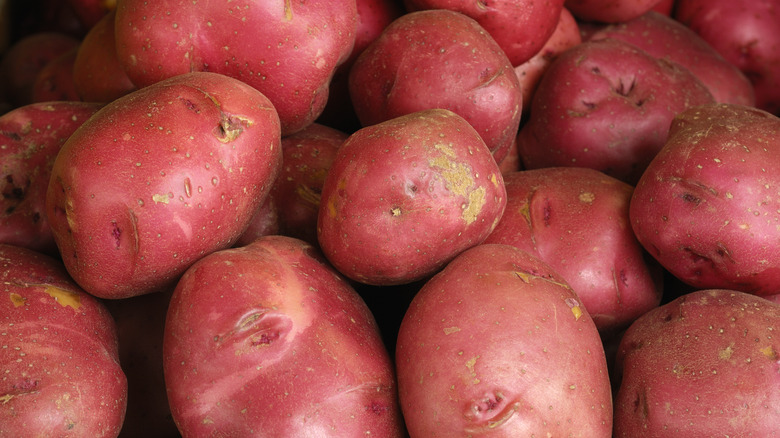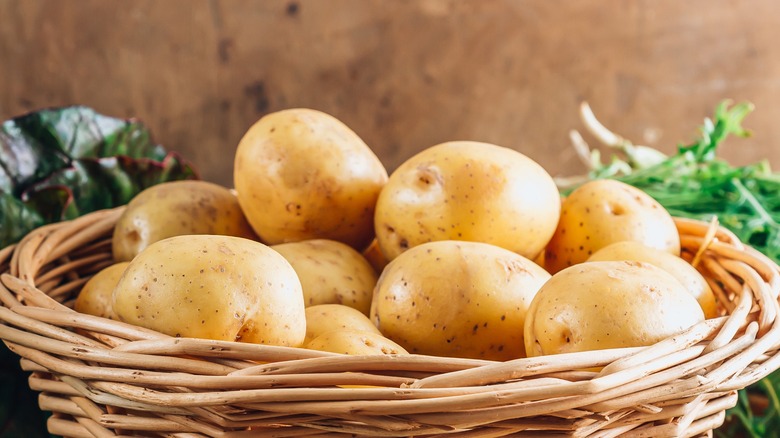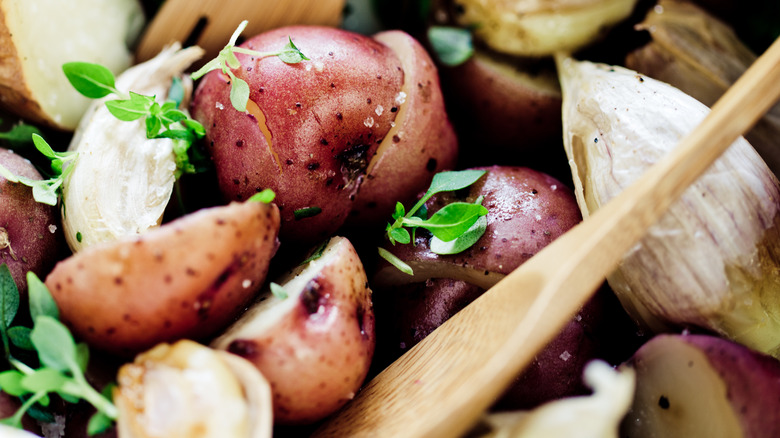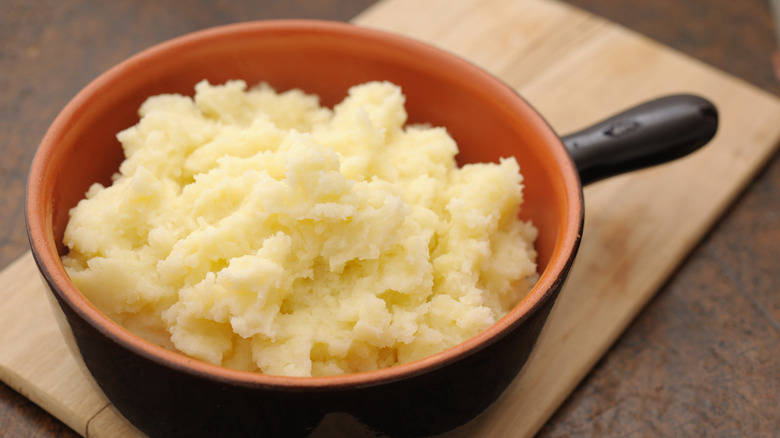Red Potatoes Vs. White: What's The Difference?
Hearty, versatile, and irreplaceable, potatoes are a staple that has literally shaped human history time and time again. The starchy veggie has traveled far from its origins in the Andes over the past centuries, and you'd be hard-pressed to find a single type of cuisine that doesn't have at least one potato-based dish. But with so many recipes specifying a white or red potato, you might have found yourself wondering at some point: What difference does it make, and does it actually matter?
In the grand scheme of things, the answer is generally "no." A potato is a potato, and there's little nutritional difference between the two varieties to make either a healthier choice in the long run. But if you get down into the nitty-gritty culinary details, the waxiness of red potatoes or the starchiness of whites bring different textures, tastes, and caveats to the table. Picking the right kind of potato can be the difference between making a great meal and making an exceptional one, so make sure you learn more about the options before choosing one for your dish.
What is a red potato?
Scientifically speaking, there's not very much that distinguishes red potatoes from white ones beyond the color. All potatoes are cultivars of the same plant species — solanum tuberosum — and their differences are a result of domestic cultivation over the centuries. What gives a red potato its signature color is a higher concentration of anthocyanin pigments in the skin. These pigments also happen to have antioxidant properties, making red potatoes a great choice for dishes that call for unpeeled potatoes.
However, in the general culinary sense, not all potatoes with red skin are considered "red potatoes." Fingerling potatoes, in particular, come in many different colors but are considered a separate category with different features and uses. If a recipe calls for a red potato, you're looking specifically for roundish, small- to medium-sized varieties with thin red skin and waxy white flesh that holds its shape after cooking. The most prominent kinds of red potatoes you can find include the Pontiac, Chieftain, Norland, and Red Bliss varieties.
What is a white potato?
Ranging from off-white to yellow in skin and flesh, a round- or oval-shaped basic white variety is probably the first thing that comes to mind when picturing a potato. Ironically, white potatoes may have darker and more warm-toned flesh compared to the light white insides of red potatoes. With a higher starch content, white potatoes also tend to be a little fluffier and softer when cooked.
An important thing to note is that while some chefs might put russets in the same category as white potatoes when comparing against waxier varieties, russet potatoes are in a starchy league of their own. They have thicker skin and retain very little structural integrity after being cooked, making them amazing for mashing and terrible for soups or salads. Meanwhile, a true white potato — such as a Kennebeck, Cascade, White Rose, or Lady Rosetta — is generally a safe choice for any kind of potato dish. It sits between russet and red potatoes on the starchy-to-waxy spectrum, performing well as an all-purpose potato with its medium starch content.
Red potatoes can be healthier than white potatoes
While the nutritional content of red and white potatoes is very similar, there are a few minor differences. They're both high in potassium and vitamin C, and they serve as equally healthy sources of carbohydrates when consumed in moderation (and outside of oil- and salt-heavy iterations like chips and fries). But there are two main reasons some might say that red potatoes are better for you in the long run.
The first is that red potatoes — due to their skin pigments — can contain as much as twice the antioxidants as white potatoes do. Considering that antioxidants promote better heart and eye health in addition to reducing the risk for certain types of cancer (per the Harvard School of Public Health), this could be seen as a pretty significant health advantage. However, this extra antioxidant content relies greatly on how pigmented that variety of red potato is, and the benefit is negated if you plan on peeling the potato before consumption.
The second reason is that red potatoes contain fewer carbohydrates on average than white varieties. The flip side is that they also contain more sugar than white potatoes. Whether it's healthier to get less carbs and more sugars from red potatoes or more complex sugars from carbohydrates via white potatoes is entirely up to the individual — so in short, red potatoes can be healthier, but not always, and preparation methods more often than not render the nutritional differences negligible.
Textural differences make red and white varieties better suited to different preparation styles
Aside from health and nutrition, the slightly different makeup of red and white potatoes also plays a huge part in how they perform as culinary ingredients. The lower starch content in red potatoes makes them better suited to dishes that require the potatoes to stay intact after cooking. Generally speaking, they're considered the best kind to use in potato salads, adding a creamy and firm texture that won't crumble under the pressure of being tossed with other ingredients. Furthermore, their higher sugar content gives them a subtly sweeter taste on their own and helps them crisp up nicely when roasted, grilled, or pan-fried. Their resilient texture also makes them excellent for steaming, adding to soups and stews, or scalloping without turning into mush.
Meanwhile, white potatoes are a great choice for any potato dish that doesn't particularly benefit from a firmer texture. Serving as the middle ground between the absolute starchiness of russets and the waxiness of red varieties, white potatoes are great for baking, boiling, frying, and steaming. White potatoes — as well as Yukon golds — can also be the best choice for mashed potatoes if you prefer a more robust texture, as they don't disintegrate quite as thoroughly as russets do.
